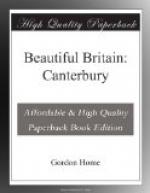[Illustration: Westgate, Canterbury, from within. This is the only survivor of the gates which studded the mediaeval walls of the city.]
From the East Station there extends as far as the site of the old Riding Gate a well-preserved length of the wall with semicircular towers at intervals, and from opposite Lady Wootton’s Green to St. Mary’s Church, standing close to the site of North Gate, lengths of the wall, with a tower at intervals, form thrillingly medieval foregrounds for the Cathedral towers. In Pound Lane the wall continues in a furtive and rather desultory fashion until it ends at the West Gate. Opposite Lady Wootton’s Green there still remain indications of a narrow postern, which is generally accepted as that through which Queen Bertha was wont to pass on her way to her devotions at St. Martin’s Church. This, however, presupposes that the portion of the wall immediately surrounding this particular point is Roman or very Early Saxon, and also that the walls of the city occupied the same position, at least as far as this point, as those built at the end of the twelfth century.
Mr. T. Godfrey Faussett’s plan of Roman Canterbury appears to carry the wall just as far as this point, and then turns at an acute angle towards the south side of the Cathedral. Following the direction Queen Bertha would have taken brings one to the great gateway of St. Augustine’s Abbey, the Benedictine monastery founded by Augustine on the land given for that purpose by Ethelbert. It was at first dedicated to St. Peter and St. Paul, and the original buildings were finished in 613. Having become the place of burial for the Kings of Kent and the Archbishops, the Abbey quite overshadowed the Priory of Christ Church, until in 758 Archbishop Cuthbert was secretly buried within the claustral confines of his own priory. At the Dissolution Henry converted the stately buildings into a palace, so that the royal visits, which had been of no infrequent occurrence in the days of monastic hospitality, continued; and while the lordly pile passed through the hands of various owners, Elizabeth, Charles I., and Charles II. paid visits on various occasions.




